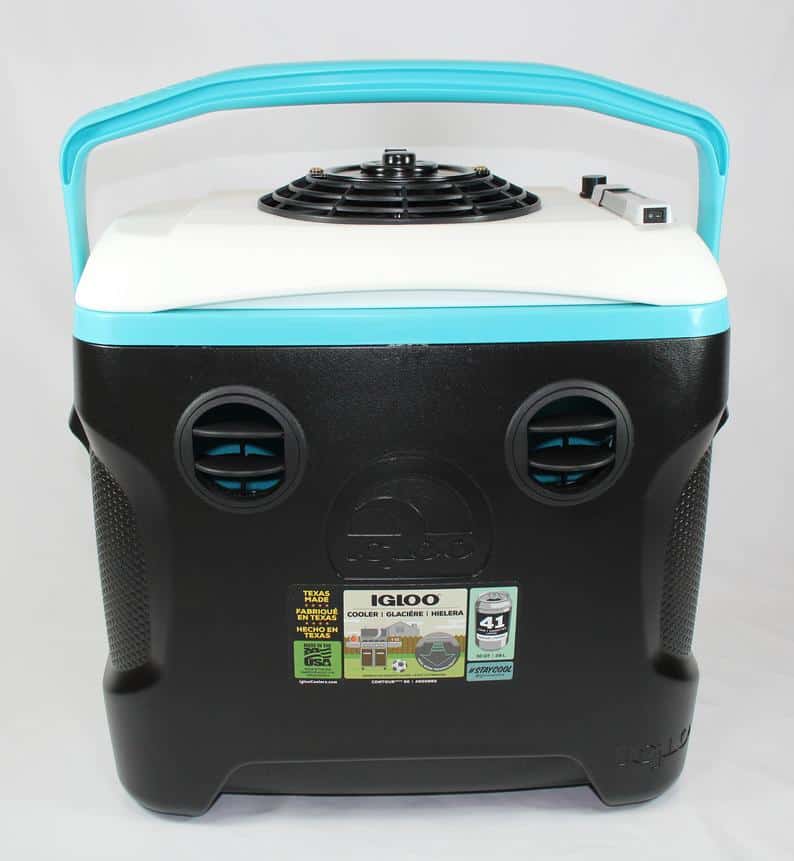Living in a RV has plenty of advantages, but let’s not sugarcoat it: they’re still metal boxes. And metal boxes can get Hellscape hot.
Figuring out how to regulate the temperature inside your RV or van becomes vital; And finding the right cooling options for your lifestyle will determine how comfortable (and livable) your vehicle is.
The following are various methods on how to keep cool in an RV.
Option #1: Modified Ice Coolers

One of the cheapest “AC” cooling options for RV / Van life is a DIY, simply constructed cooler with modifications.
This camping “AC” consists of a cooler, mini-fan, tubing (for the air to escape and cool), sharp tool to cut a styrofoam/regular cooler, a plug for an AC (alternating current) outlet and a bag of ice.
Every summer YouTube blows up with viral videos of people trying to beat the heat by making their own versions of this DIY cooler, and they can be effective… within reason.
These DIY air cooling systems can’t compete with a regular air conditioning unit, but they can cool down a room and make you more comfortable.
If you decide to go with the DIY approach, the approximate cost to make one yourself will look something like this:
Cooler: Between $25 – $200+, depending on the company and quart size
Mini-Fan: Between $12 – $50, again depending on the brand/size. If you do go this route, make sure you choose a strong fan- it’s what will be pushing the cold air out of the cooler and into your room
PVC Pipe: From $8 and up; Depending on how you’re building your cooler, the size and shape will vary
Feeling cool air on a sweaty-ass day: Priceless
These can be made on the cheap, so it’s an affordable option for how to keep cool in a RV without AC.
Personally, after making one last year with a styrofoam cooler (then proceeding to accidentally fall on it), we decided to purchase one already made. Coolinnoventions sells various sizes of these cooling units, ranging from $120 – $330, depending on your needs.
Ours has been helpful taking the edge off of hot summers in southern CA when we can’t use our regular RV air conditioner. It’s also been useful keeping the temperature down for our cat who’d otherwise have a very difficult time in a hot RV.
Understand that this option does have its limits, and if it’s extremely hot, you’ll need another, stronger cooling method. And remember: Never leave your pets in a hot RV without a way to keep it cool inside!
Pro TIP: When using a DIY cooling unit, pour Rock Salt over the ice in your cooler. Rock Salt helps bring the ice to an even colder temperature, as the salt lowers it’s freezing/melting point.
So, although your ice will melt more quickly- don’t worry- the Rock Salt makes the liquid water COLDER than it was when it was frozen ice!
Option #2: Small RV Air Conditioner

Nothing can cool a small space quite like a regular air conditioning unit. But when you’re living in a RV or van, it’s not always as simple as running a sticks-and-bricks air conditioner.
In general, running an AC in your vehicle comes with limitations that you don’t normally encounter in a more traditional house.
In order to run an air conditioner in your tiny home, you’re going to need to give it power.
A lot of power.
In order to feed this power-hungry appliance you have a few options:
Shore Power: Shore Power is a fancy way of saying “plugging in to the grid”. This method gives you the most bang for your buck and gives you a lot of energy to power up your appliances, including your RV’s air conditioning unit.
With that said, before going whole hog in to RV/vanlife and think you can run your air conditioner as often and as long as you’d like, make sure you understand how shore power works (we wrote up a full explanation for you here).
As with all things in life, there are caveats and important things you’ll need to know for life on the road, and understanding your AC/DC system is one of the most essential.
Generator: This seems to be the most common among RVers. Running your air conditioner this way can be easy and effective: Generators are typically powerful enough to give your A/C enough long-lasting juice to cool down your RV.
But this comes at a cost: Generators run off of fuel, so the more you use it, the more you’ll end up paying to gas up the appliance.
So depending on the climate you’re living in, you could rack up a bigger fuel bill than you expected.

Generators are also notorious noise-makers (although units like the Honda Eu2200i are said to run relatively quietly). But just by virtue of running a gas-powered engine to utilize your AC, you will make noise, and for many this can be a problem.
If you’re staying in a RV park, there are noise rules to abide, so a generator can’t run 24/7.
Similarly, staying in parking lots and other urban areas, noise can be a problem; Locals don’t generally look too kindly on vehicle-dwelling noise-makers, so keeping a low profile while running a generator for some cool air can prove difficult.
But running your generator for an AC does has some major benefits: The power it gives to your air conditioning unit is unparalleled. Just switch it on, and an AC unit can cool up a small space in a matter of minutes.
When we’re able, running our AC on our Onan Generator has been a godsend in hot weather.
Solar Panels: There’s a perpetual myth living on the internet that air conditioners can’t run off of solar- which is untrue.
However, to do this, you typically need to have a fairy large solar kit set up (which can be expensive). We don’t have personal experience with this option, but you can find plenty of information online if you’re interested in running your AC off of solar.
Option #3: Fans

Technically not an air conditioner, but fans are an essential appliance for any RV or van. Living in a such a small space, there are a few reasons why fans are needed:
Keeping Cool: One unavoidable aspect of RV life is heat, and as explained earlier, you won’t always be able to use your AC unit every time it gets hot.
In order to keep the temperature more comfortable during those days, ceiling fans are Problem Solver #1. When purchasing a RV or van, ceiling fans are normally already installed, the most ubiquitous being the Fantastic Fan; These fans can be used to suck warm, stale air out of your camper, or to bring cool air from the outside into the cabin.
With a ceiling fan and open windows during hot days, a little bit of air flow can make a big difference in comfort.
Ventilation: Those new to RV/Van (and boat!) life might not realize how important ventilation is in a tiny dwelling.
Unlike a traditional house, vehicles will become warm causing moisture to develop, and moisture is your enemy.
It can- and will- appear in bathrooms, kitchens, in the bed area above the driver’s seat, and on windows in the cabin.
Once moisture sets in, it can cause problems like mold (which is dangerous to breathe), lead to roof damage or rusting of metal in your vehicle.
One of your most powerful weapons against moisture is a ventilation fan (even better if you have more than one fan your tiny house).
In our own RV, we have four fans to keep cool air flowing and to maintain a low-moisture environment: A Fantastic fan in our bathroom, Fantastic fan in our cabin, a 15 inch Honeywell fan in our bed area (which is essential for us), and the Turbo Honeywell fan in the living area.
Having these set up has made full-time RV life much easier and exponentially more comfortable.
Option #4: Beachfront Parking (Nature’s Air Conditioner)

Living in a tiny house on wheels does have some major perks, like parking your house on the beach.
We live in southern California which has a beautiful coastline, plenty of RV campgrounds, and a cool breeze that can’t be beat.
When July and August roll around, temperatures can rise to well over 100°F in our area, and the easiest, most enjoyable “air conditioner” is riding up to the sand, opening up all the windows, and feeling that breeze rush through our RV.
No matter where you live, in a RV or van you have the freedom to travel anywhere you want- avoiding the hot seasons and travelling to more habitable climates.
No packing necessary: just rev up your engine and your home is ready for some new scenery!

Summer stays at the beach are popular, so before making a long drive out to the coast, make sure you check the sites you’re thinking of visiting for availability.
Depending on what kind of site you plan to visit (Day Use Only VS Overnight Camping), some sites require reservations and fill up fast.
Like anything in RV/van life, do a little research before you take off on a road trip; This can save you a lot of time, gas, and sanity.
And if you do end up making a trek down to the beach in your rolling home, just know: It can get addicting.
Happy travels and keep cool!

